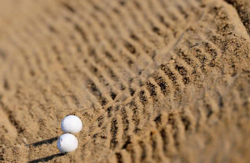Bunkers seem to be the hot topic with regards to rulings in 2010, and as an official at the U.S. Mid-Amateur Championship that was recently held at Atlantic Golf Club in Bridgehampton, N.Y., I experienced it firsthand. The bunker ruling I made had multiple parts and seemed slightly complicated, but by breaking down each part, it’s very easy to understand.
On Saturday at Atlantic the sun was shining but the wind was blowing around 20-25 miles per hour. I was stationed around the 4th hole–a par 3 that was set at 178 yards with bunkers surrounding the green, and a cliff to the right of these bunkers that spelled “lost ball” for any errant shots that ventured that way. The wind, of course, was dead into the players’ faces, making the hole play much longer. The left greenside bunker became a popular spot to miss into as players did not want to flirt with the right side. In one group, two balls came to rest in this bunker about a half inch apart, which brought up a few different rules scenarios for the players to address with me.
In this scenario, there was an obvious interference problem as it was impossible for Player A to make a stroke at his ball without moving Player B’s ball. Rule 22-2 states “if a player considers that another ball might interfere with his play, he may have it lifted.” Therefore, Player B marked the position of his golf ball, and because his mark would also most likely move when Player A makes a stroke at his ball, Player B moved his mark one clublength to the right (using a similar procedure to moving your mark out of a player’s line of putt).
Player A then played his stroke from the bunker, and in doing so altered Player B’s original lie. Decision 20-3b/6 states that the original lie must be recreated and the ball must be replaced in that lie. So after Player A played, Player B recreated his original lie by first raking the area (which is allowed under this rule) and then placing his ball back in the original lie (after measuring one clublength, remember). Note that Rule 13-4 (Ball in Hazard; Prohibited Actions) does not override Rule 20-3b (Lie of Ball Altered) in this situation. Player B had to replace his ball in this lie in the bunker, thus not having to worry about a “fried egg” lie he might have had had he dropped the ball. However, if his original lie had been buried, he would have to recreate the lie to its original buried condition.
The key to remembering this rule is that when the lie of your golf ball has been altered in a bunker, you must always recreate your original lie and replace the ball in it.


